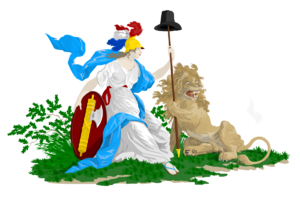User:Frans/drafts2: Difference between revisions
No edit summary |
No edit summary |
||
| Line 2: | Line 2: | ||
Featured picture | Featured picture | ||
</div> | </div> | ||
{| | {|style="width: 100%; | ||
|style="width:33%;" rowspan="2" | [[File:1200px-Jack on the navy flag of the Batavian Republic.svg.png|300px| | |style="width:33%;" rowspan="2" | | ||
[[File:1200px-Jack on the navy flag of the Batavian Republic.svg.png|300px|center|dutch maiden]] | |||
|The Dutch Maiden ''(Nederlandse Maagd)'' is a national personification of the Netherlands. She is typically depicted wearing a Roman garment and with a lion, the Leo Belgicus, by her side. In addition to the symbol of a national maiden, there were also symbolic provincial maidens and town maidens. | |The Dutch Maiden ''(Nederlandse Maagd)'' is a national personification of the Netherlands. She is typically depicted wearing a Roman garment and with a lion, the Leo Belgicus, by her side. In addition to the symbol of a national maiden, there were also symbolic provincial maidens and town maidens. | ||
The Dutch Maiden has been used as a national symbol since the 16th century. During the Dutch Revolt, a maiden representing the United Provinces of the Netherlands became a recurrent theme in allegorical cartoons. In early depictions she may be shown in the "Garden of Holland", a small garden surrounded by a fence, recalling the medieval hortus conclusus of the Virgin Mary. On 25 May 1694, the States of Holland and West Friesland introduced a uniform coin design for the United Provinces, showing a Dutch Maiden leaning on a bible placed on an altar and holding a lance with the cap of liberty, the Liberty pole. | The Dutch Maiden has been used as a national symbol since the 16th century. During the Dutch Revolt, a maiden representing the United Provinces of the Netherlands became a recurrent theme in allegorical cartoons. In early depictions she may be shown in the "Garden of Holland", a small garden surrounded by a fence, recalling the medieval hortus conclusus of the Virgin Mary. On 25 May 1694, the States of Holland and West Friesland introduced a uniform coin design for the United Provinces, showing a Dutch Maiden leaning on a bible placed on an altar and holding a lance with the cap of liberty, the Liberty pole. | ||
The Dutch maiden was also used by the | The Dutch maiden was also used by New Batavia's predecessors the [[Netherlands|Republic of the Netherlands]] and the [[Islamic Internet Republic]]. | ||
|- | |- | ||
| style="font-size: x-small; | | | style="font-size: x-small; | Read more: | ||
* Wikipedia page on the [[Wikipedia:Dutch Maiden|Dutch Maiden]] | |||
* [[Coat of arms of New Batavia]] | |||
|} | |} | ||
Revision as of 14:44, 29 November 2020
Featured picture
 |
The Dutch Maiden (Nederlandse Maagd) is a national personification of the Netherlands. She is typically depicted wearing a Roman garment and with a lion, the Leo Belgicus, by her side. In addition to the symbol of a national maiden, there were also symbolic provincial maidens and town maidens.
The Dutch Maiden has been used as a national symbol since the 16th century. During the Dutch Revolt, a maiden representing the United Provinces of the Netherlands became a recurrent theme in allegorical cartoons. In early depictions she may be shown in the "Garden of Holland", a small garden surrounded by a fence, recalling the medieval hortus conclusus of the Virgin Mary. On 25 May 1694, the States of Holland and West Friesland introduced a uniform coin design for the United Provinces, showing a Dutch Maiden leaning on a bible placed on an altar and holding a lance with the cap of liberty, the Liberty pole. The Dutch maiden was also used by New Batavia's predecessors the Republic of the Netherlands and the Islamic Internet Republic. |
Read more:
|